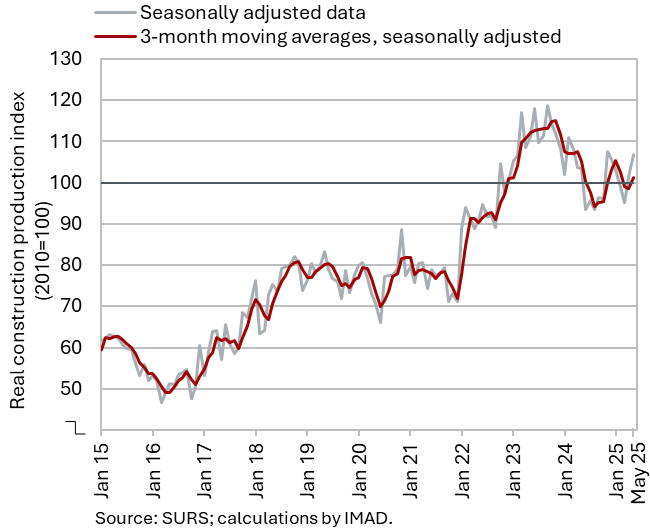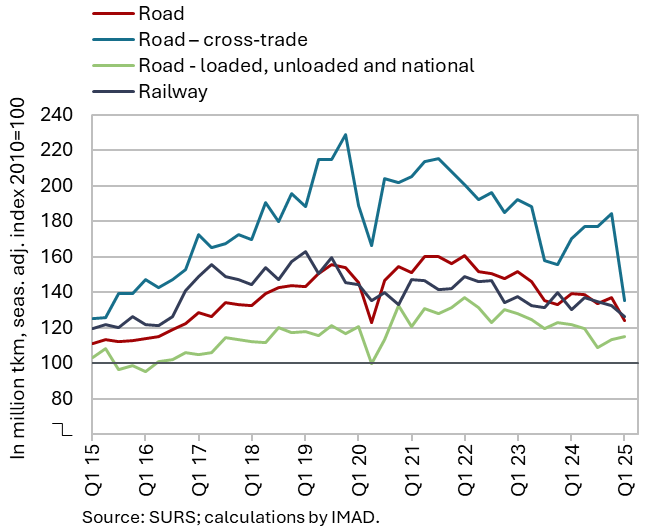Charts of the Week
Charts of the week from 14 to 18 July 2025: activity in construction, number of persons in employment, current account of the balance of payments, road and rail freight transport
Following a decline in the first quarter, construction activity increased in April and May, exceeding the level recorded in the same period last year. In the first five months of the year, it was lower than in the same period last year, with the most pronounced decline observed in civil engineering. The number of persons in employment remained broadly unchanged in May compared with previous months (seasonally adjusted), while it was slightly lower year-on-year (original data). The 12-month current account surplus (until May) amounted to EUR 2.8 billion (4.0% of estimated GDP), which is EUR 103,2 million higher than in the previous 12-month period. The main contributor to the increase was a smaller primary income deficit. The volume of road and rail freight transport continued to decline in the first quarter of 2025 (seasonally adjusted); it was also lower year-on-year.
Activity in construction, May 2025

Following a decline in the first quarter, construction activity increased in April and May, exceeding the level recorded in the same period last year. It declined in the first quarter but strengthened in April and May (by 7% and 5% respectively compared to the previous month). In May, the value of construction put in place was 3% higher year-on-year. In the first five months, the value of construction put in place was 5% lower than in the same period last year. The largest year-on-year decline was recorded in the construction of civil engineering works (–16%), which is traditionally linked to government investment activity. Capital expenditure (according to the consolidated general government budgetary accounts) was 1% higher year-on-year in the first five months; within this, expenditure on new constructions, reconstructions, and renovations – which, in our assessment, is most closely related to construction activity – remained roughly unchanged. The lower activity in civil engineering at the beginning of this year may thus be related to reduced investment by infrastructure companies and/or budgetary funds.
Number of persons in employment, May 2025

The number of persons in employment remained broadly unchanged in May compared with previous months (seasonally adjusted). On a year-on-year basis, it was 0.5% lower. The largest decline occurred in other administrative and support service activities (–4.1%), mainly due to a decline in employment agencies. The number of persons in employment was also significantly lower than a year ago in manufacturing and construction (both –2.1%); the latter still faces a labour shortage, as indicated by the job vacancy rate. In contrast, year-on-year growth was observed in public service activities, particularly in human health activities (3.3%) and education (1.6%).
Current account of the balance of payments, May 2025

The 12-month current account surplus (until May) amounted to EUR 2.8 billion (4.0% of estimated GDP), which is EUR 103,2 million higher than in the previous 12-month period. The main contributor to the increase was a smaller primary income deficit, primarily due to lower net outflows of income from equity capital (dividends and profits) and higher subsidies received from the EU budget. The surplus in services also increased, primarily due to trade in technical, trade-related, and research and development services. In contrast, the current account surplus was negatively affected by a higher deficit in secondary income (owing to lower net transfers received by the general government sector and higher net transfers paid abroad by the private sector) and a lower goods surplus (a result of a higher deficit with EU countries).
Road and rail freight transport, Q1 2025

The volume of road and rail freight transport continued to decline in the first quarter of 2025 (seasonally adjusted); both were also lower year-on-year. In road transport performed by Slovenian vehicles, the volume of cross-trade declined by more than a quarter, while the volume of transport at least partly taking place on Slovenian territory (exports, imports and national transport) increased slightly for the second consecutive quarter (total road transport declined by 9%). The share of cross-trade in total transport fell below 38%, reaching its lowest level in the past ten years. According to Eurostat data, cross-trade by Slovenian vehicles had been increasing rapidly before the COVID-19 pandemic, but in the five years to 2024 it declined by 16%, while in the EU it continued to grow by more than 10% (with the largest contributions from Polish, Lithuanian and, to some extent, Czech hauliers). Rail freight transport on Slovenian territory fell by more than 4% in the first quarter (seasonally adjusted) and was also down by about the same percentage year-on-year. Compared with the same quarter in 2019, it lagged even further behind than road transport – by as much as 22%.
